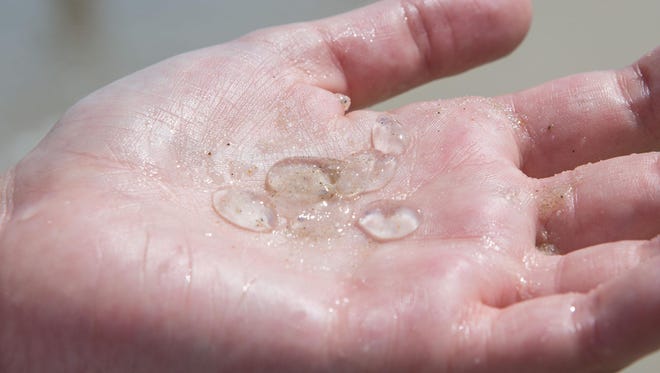Salp 'invasion' a reminder of world beneath the waves

Last week's invasion of clear, bubble-shaped, jellyfish-looking creatures has subsided along the Delaware and Maryland beaches.
Truthfully, it was never an invasion.
Salps, as the jelly blobs are called, aren't actually jellyfish. And they're certainly not invaders. They're commonly found off the coast of Delmarva farther out into the ocean. The ocean current and an east wind brought them to shore.
"If you have sort of favorable winds, something that's pushing them toward the coast or other oceanographic conditions, you can have all the sudden something that typically is found a little farther offshore getting washed up on the beach," University of Delaware scientist Jon Cohen said.
While the salps don't sting, beachgoers were still alarmed to find thousands of them on the beach and, therefore, on their bodies when they left the water.
Big creatures always tend to make noise when they're sighted along the coast, but in the complex ecosystem that is the ocean, life is thriving in the waves on a scale too small to easily see.
The question is when do humans notice this life? And the answer is when they have an itch in their swimsuit.
When people complain of being bit by "sea lice," that is never the case. Sea lice are a different organism altogether, which impact fish and not people. But there are other explanations.
Cohen, a zooplankton specialist, said there are a few types of tiny creatures that could irritate beachgoers.

Many crab species, including blue crabs, release larvae while the tide is headed out to the sea to grow up in the coastal ocean. The tiny larvae, less than a millimeter in size during some stages, don't bite, but they do have jagged bits of shell, which can poke.
"They're not really biting you, they're just having sharp things on them that would then sort of poke into you, accidentally," Cohen said.
Another zooplankton that causes discomfort is jellyfish. While many people think "small" when they hear plankton, zooplankton is a broad term that covers any animal incapable of fighting the water's current.
That includes the Portuguese man-o-wars spotted off Delaware recently. Jellyfish stings are typically apparent to people, but what they might not know is that the nature of tentacle cells allows the cells to retain the ability to sting even after breaking off from the larger organism. You could get a small sting from a broken tentacle, even without a jellyfish nearby.
"It survives, not forever, but it certainly can still sting you," Cohen said. "They're independent little cells."
The same can be true for pieces of sea anemone which may rub off a dock, Cohen said.
"The other thing is, it could just be sand. Just the irritation of sand, I think people sort of maybe forget that sometimes. Especially if you don't spend a lot of time in the sun or by the ocean," Cohen said. "The sun and the sand and the salt are abrasive."
rpacella@dmg.gannett.com
443-210-8126
On Twitter @rachaelpacella